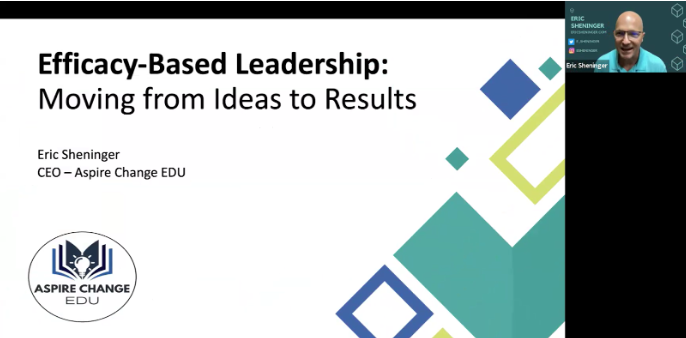Efficacy-Based Leadership with Eric Sheninger
September 09, 2024

AASA’s new Innovation for Transformation Consortium kicked off the year with renowned education thought leader and Aspire Change EDU’s CEO, Eric Sheninger!
Sheninger, known for his practical approaches to school improvement, challenged district leaders to rethink their approach to change and how to measure success.
“Questions are more important than answers,” Sheninger said, setting the tone for a presentation focused on reflection and growth. He urged participants on the call to constantly examine, “Why do you do things the way you do them?; How might you do it better? And, most importantly, what tells you if you are successful?”
Some other key takeaways from Sheninger’s presentation include:
Redefining Innovation: “Innovation is new, better, and actual evidence of result.” This could be as simple as a teacher consistently implementing lesson closure and using technology to get instant feedback on whether learning targets were met.
Importance of Assimilation: “Innovation only matters if it becomes assimilated in the majority of classrooms,” Sheninger emphasized. He acknowledged the reality that not everyone will change, but stressed the importance of creating a “new status quo” where every learner can succeed.
Leadership is Not About Telling: “Leadership is not telling people what to do. You don't like to be told what to do... Leadership is taking people where they need to be.” He challenged leaders to show the value of transformation by demonstrating how it saves time, isn't more work, but better work.
Moving Beyond “Best Practices”: Sheninger challenged the notion of “best practices” in education. “When we think about leadership, there isn't a best way to lead. There isn't one approach that's going to lead to scalable transformation.” Instead, he advocated for “effective practices” determined by local context and evidence.
The Power of Evidence: Throughout the presentation, Sheninger emphasized the importance of collecting and sharing evidence of transformation. “I love being able to show... well-designed rotations where data is used to group, regroup, target instruction, differentiate,” he shared, highlighting the power of visual evidence in driving change.
Asking the Right Questions: Sheninger shared some of his favorite questions for classroom observations, including “How do you know kids learned?” and “What do you think the students thought about the lesson?” These open-ended queries promote reflection and dialogue rather than top-down directives.
Involving Students: “There's no better way to show the impact of transformation than through student voice and through their work.”
Sheninger shared many more thought-provoking questions and ideas for AASA members to think about as they carry out effective and positive district transformation that involves the entire school community. He reminded participants that transformation is an ongoing process (not an event), requiring honesty, vulnerability and a willingness to challenge the status quo.
Innovation for Transformation Consortium
AASA’s new Innovation for Transformation Consortium is designed to inspire and support educational leaders in driving dynamic change, combining expertise in transformational leadership, innovative and personalized student learning experiences, and STEM education to create powerful opportunities for growth and advancement in schools across the nation.
There’s still time to register for the Consortium and attend all upcoming meetings, including an in-person site visit to Indian Hill Exempted Village Schools in Ohio October 6 - 8, 2024!
Advertisement
Advertisement
Advertisement
Advertisement

.png?sfvrsn=53cf74f6_7)
